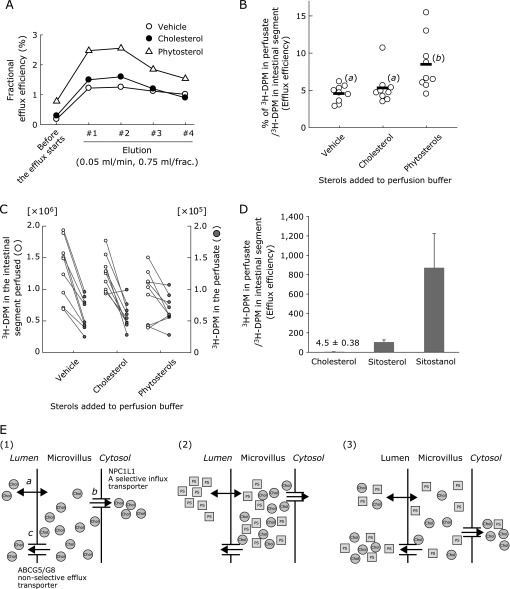Fig. 1.
Luminal phytosterols increase intestinal cholesterol efflux. (A) Elution patterns of 3H-cholesterol from the cannulated intestinal segments. Each plot indicates the mean (n = 9). (B) Efflux efficiency (%; sum of #1–#4) in the presence of phytosterols or cholesterol in the luminal perfusate. Different letters in parenthesis indicate a statistically significant difference between the groups using Tukey’s Honestly Significant Difference test. (C) Plots for 3H-decay per minute (DPM) in the perfusate (left; sum of #1–#4) and intestinal segment perfused (right). (D) Sterol efflux efficiency determined by luminal perfusion assay (the original data were previously reported and are shown as a liner bar graph with mean ± SD).(3) (E) Proposed model for phytosterol-mediated brush border membrane (BBM)-to-lumen cholesterol efflux. (1) a, sterols diffuse into or out of the BBM; b, Niemann-Pick C1-like 1 (NPC1L1), a sterol-selective influx transporter, transfers sterols, preferentially cholesterol, for further absorptive processes. c, ATP-binding cassette (ABC) G5/G8 pumps out sterols to the lumen non-selectively. (2) and (3) show phytosterols (PS) behavior when present in the intestinal lumen in a successive manner (2 to 3). (2), Luminal phytosterols enter the BBM and compete with cholesterol already present in the BBM. (3), When sterols in the BBM are effluxed into the lumen, both the passive diffusion and ABCG5/G8 do not discriminate between sterol species and, as a result, cholesterol present in the BBM is diluted with plant sterols. Such dilution of cholesterol in the BBM can reduce the efficiency of NPC1L1-mediated cholesterol transport.

